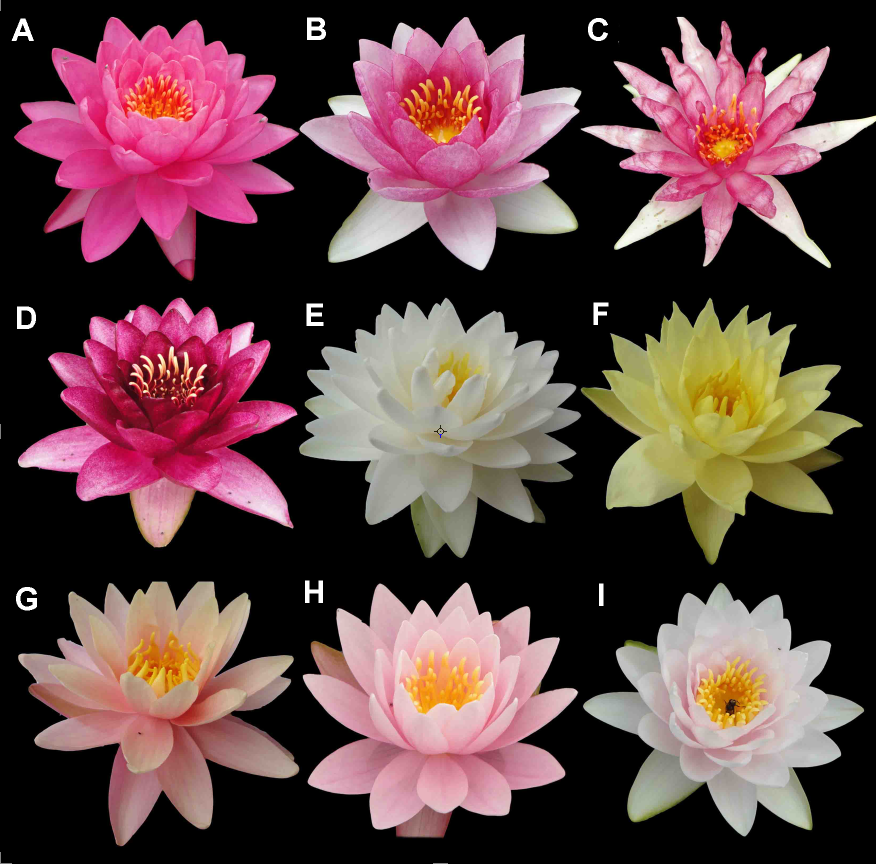Relationship Between the Composition of Anthocyanins and Flower Color Variation in Hardy Water Lily (Nymphaea spp.) Cultivars
- ZHU Man-Lan ,
- YU Liang-Sheng ,
- ZHANG Hui-Jin ,
- XU Pan-Jun ,
- ZHENG Xu-Chen ,
- YU Li-Jin
- 1College of Horticulture, Nanjing Agricultural University, Nanjing 210095, China;
2Beijing Botanical Garden/Key Laboratory of Plant Resources, Institute of Botany, Chinese Academy of Sciences, Beijing 100093, China;
3Department of Applied Chemistry, China Agricultural University, Beijing 100094, China;
4Graduate University of the Chinese Academy of Sciences, Beijing 100049, China
Received date: 2012-03-30
Revised date: 2012-05-17
Online published: 2012-07-24
Abstract

Key words: anthocyanin; flower color; hardy water lily; HPLC-DAD; HPLC-ESI-MSn
Cite this article
ZHU Man-Lan , YU Liang-Sheng , ZHANG Hui-Jin , XU Pan-Jun , ZHENG Xu-Chen , YU Li-Jin . Relationship Between the Composition of Anthocyanins and Flower Color Variation in Hardy Water Lily (Nymphaea spp.) Cultivars[J]. Chinese Bulletin of Botany, 2012 , 47(5) : 437 -453 . DOI: 10.3724/SP.J.1259.2012.00437
References
李清清, 黄娟英, 吉建斌, 孟庆贵, 杨春菊, 赵广胜 (2005). 水生花卉中的女神-睡莲. 园林绿化10, 45-46.
史屹峰 (2009). 优良水生花卉-荷花及睡莲. 中国果菜 8, 40-41.
张 洁,王亮生,高锦明,李圣波,徐彦军,李崇晖,杨瑞珍(2011)。贴梗海棠花青苷组成及其与花色的关系。园艺学报38,527–534.
中国科学院中国植物志编辑部 (1979). 中国植物志. 北京: 科学出版社. 27, 8-12.
Afaq F, Syed DN, Malik A, Hadi N, Sarfaraz S, Kweon MH, Khan N, Zaid MA and Mukhtar H (2007). Delphinidin, an anthocyanidin in pigmented fruits and vegetables, protects human HaCaT keratinocytes and mouse skin against UVB-mediated oxidative stress and apoptosis. J Invest Dermatol 127, 222-232.
Bomser J, Madhavi DL, Singletary K, Smith MAL (1996). In Vitro Anticancer Activity of Fruit Extracts from Vaccinium Species. Planta Med 62, 212-216.
Cuyckens F, Claeys M (2004). Mass spectrometry in the structural analysis of flavonoids. J Mass spectrom 39, 1-15.
Fossen T, Andersenet ?M (1997). Acylated anthocyanins from leaves of the water lily, Nymphaea × Marliacea. Phytochemistry 46, 353-357.
Fossen T, Andersenet ?M (1999). Delphinidin 3′-galloylactosides from blue flowers of Nymphaea caerulea. Phytochemistry 50, 1185-1188.
Fossen T, Andersenet ?M (2001). Cyanidin 3-(6"-acetyl) and other anthocyanins from reddish leaves of the water lily Nymphaea alba. J Hortic Sci Biotech 76, 213-215.
Fossen T, Larsen ?, Andersenet ?M (1998). Anthocyanins from flowers and leaves of Nymphaea × Marliacea cultivars. Phytochemistry 48, 823-827.
Fukui Y, Tanaka Y, Kusumi T, Iwashita T, Nomoto K (2003). A rationale for the shift in colour towards blue in transgenic carnation flowers expressing the flavonoid 3,5’-hydroxylase gene. Phytochemistry 63, 15-23.
Gonnet JF (1998). Colour effects of co-pigmentation of anthocyanins revisted-1. A colorimetric denition using the CIELAB scale. Food Chem 63, 409-415.
Gonnet JF (1999). Colour effects of co-pigmentation of anthocyanins revisted-2. A colorimetric look at the solutions of cyanin co-pigmented by rutin using the CIELAB scale. Food Chem 66, 387-394.
Harborne JB (1958). Spectral methods of characterizing anthocyanins. J Biochem 70, 22-28.
He QL, Shen Y, Wang MX, Huang MR, Yang RZ, Zhu SJ, Wang LS, Xu YJ, Wu RL (2011). Natural variation in petal color in Lycoris longituba revealed by anthocyanin components. PLoS ONE 6, 1-8.
Holton TA, Brugllera F, Lester DR (1993). Clonging and expression of cytochrome P450 genes controlling flower color. Nature 366, 276-279.
Hou DX, Yanagita T, Uto T, Masuzaki S and Fujii M (2005). Anthocyanidins inhibit cyclooxygenase-2 expression in LPS-evoked macrophages: structure-activity relationship and molecular mechanisms involved. Biochem Pharmacol 70, 417-425.
Jurani? Z, ?i?ak Z (2005). Biological activities of berries: From antioxidant capacity to anti-cancer effects. BioFactors 23: 207-211.
Kalt W, Lawand C and Forney CF (2000). Antioxidant capacity and anthocyanin and phenolic content of highbush blueberries of different maturities. Hortscience 35, 394.
Stone SZ, Yasmin T, Bagchi M, Chatterjee A, Vinson JA, Bagchi D (2007). Berry anthocyanins as novel antioxidants in human health and disease prevention. Mol. Nutr. Food Res 51, 675-683.
Vijai KA, Hala NE, Shabana IK, Troy JS, Ikhlas AK, Larry AW (2008). Antioxidant constituents of Nymphaea caerulea flowers. Phytochemistry 69, 2061-2066.
Zhu ML, Zheng XC, Shu QY, Li H, Zhong PX, Zhang HJ, Xu YJ, Wang LJ, Wang LS (2012). Relationship between the composition of flavonoids and flower colors variation in tropical water lily (Nymphaea) cultivars. PLoS ONE doi: 10.1371/journal.pone.0034335.